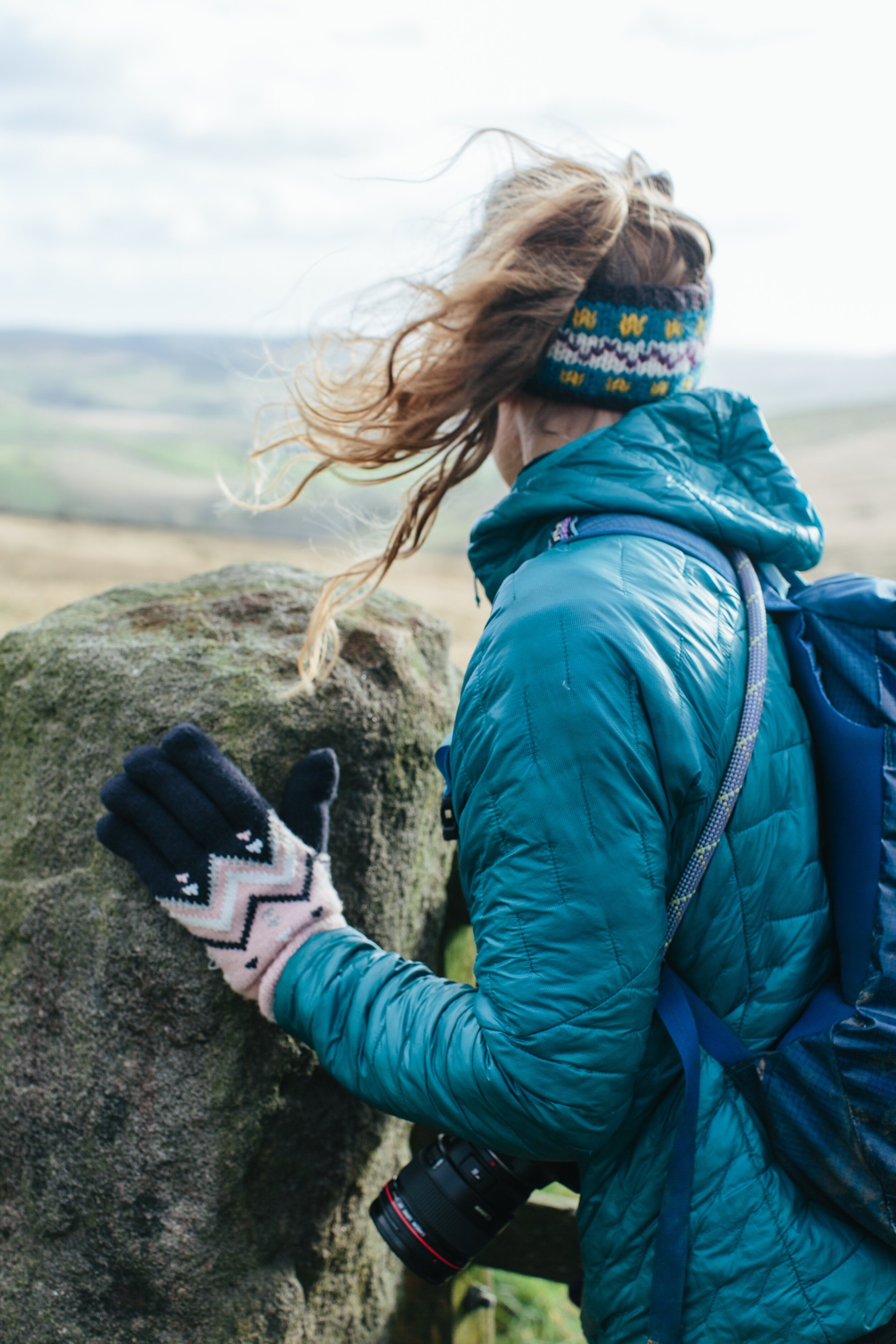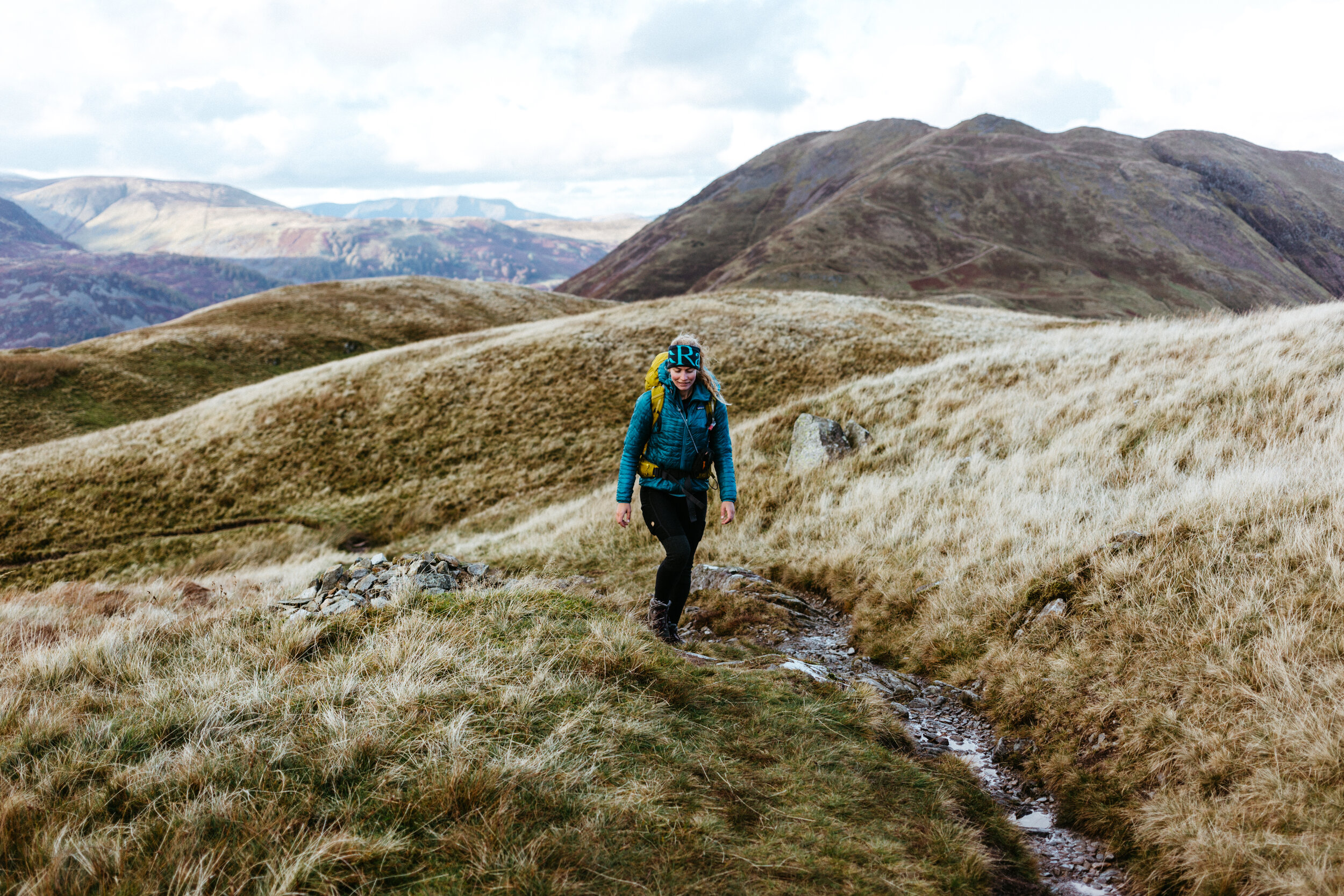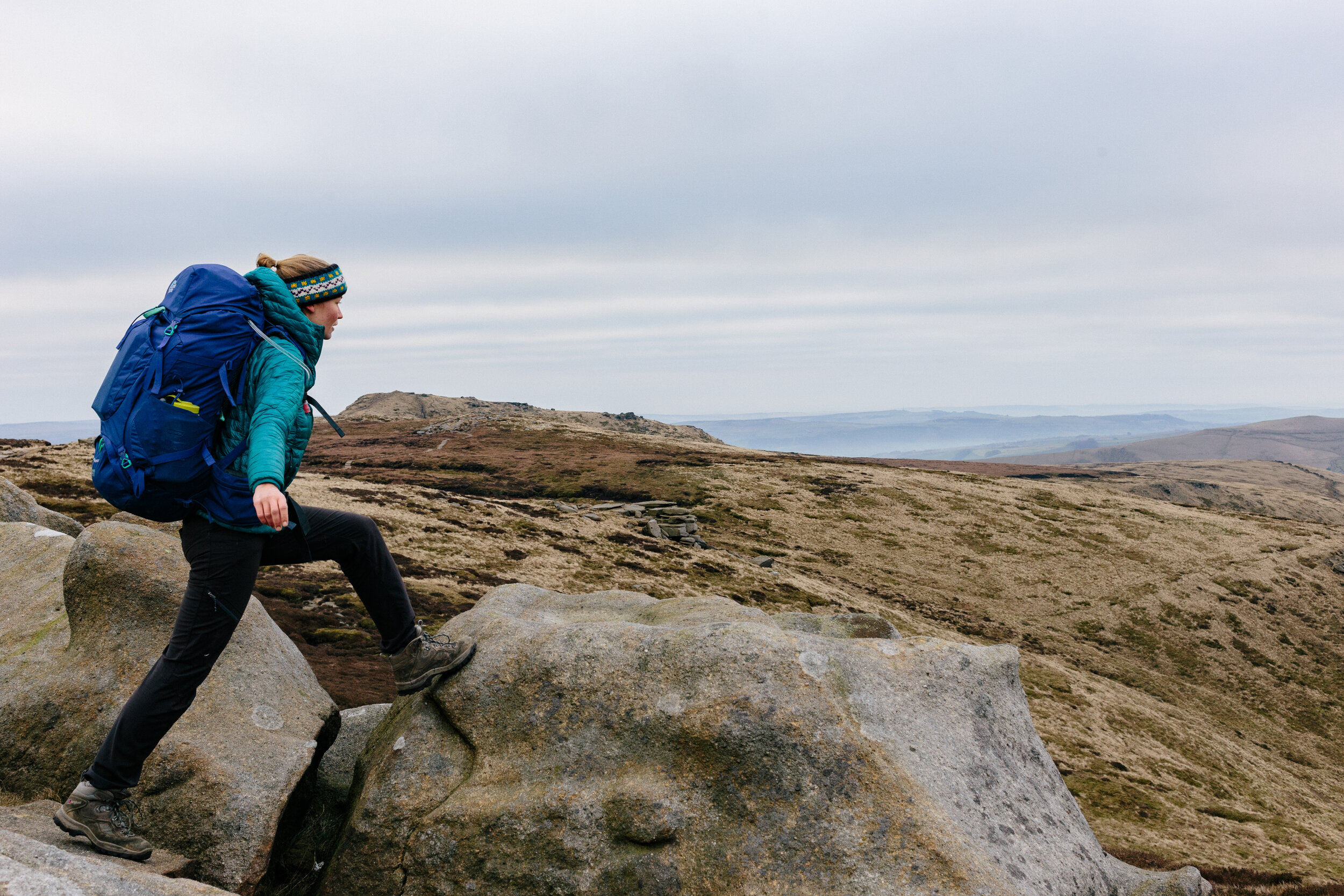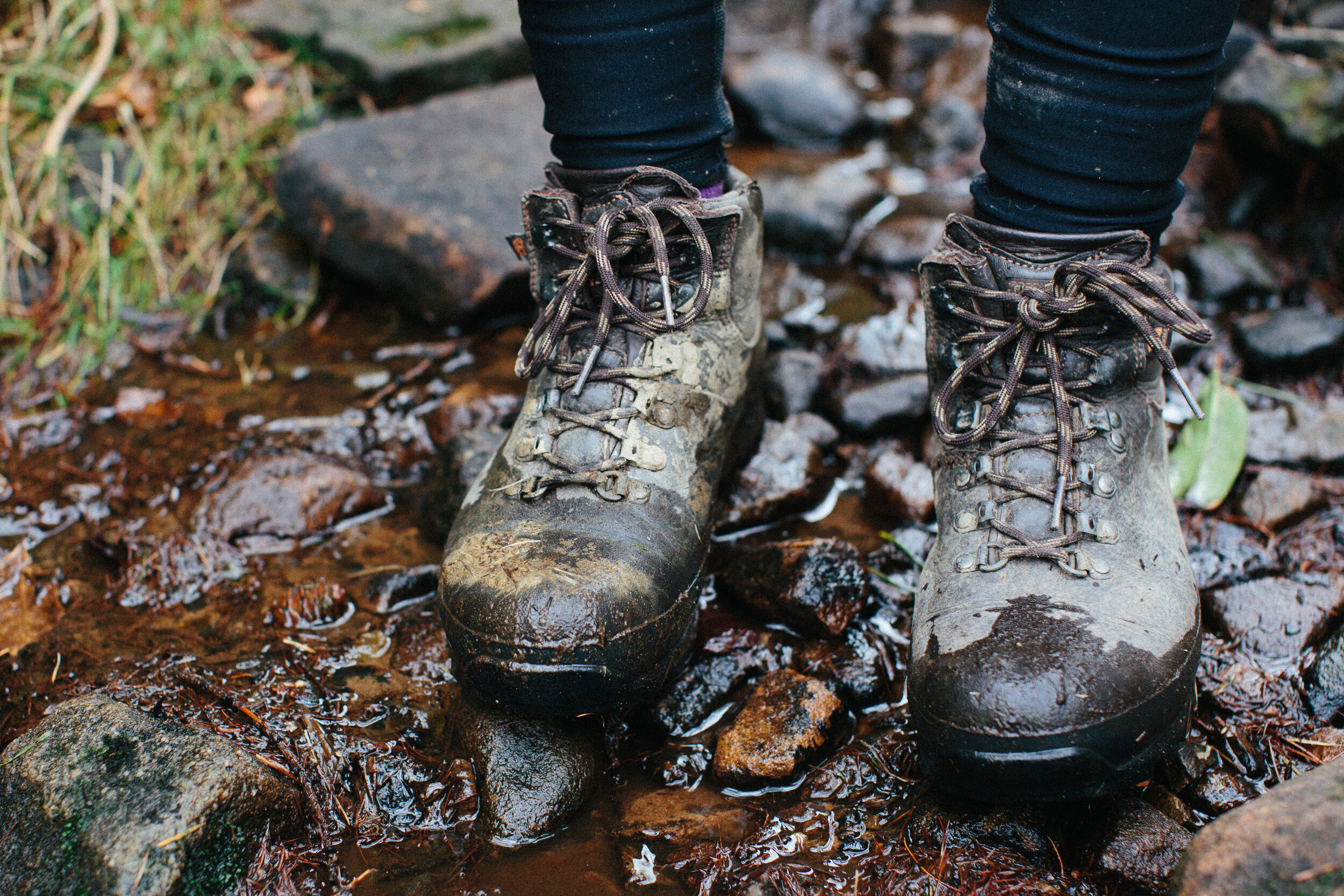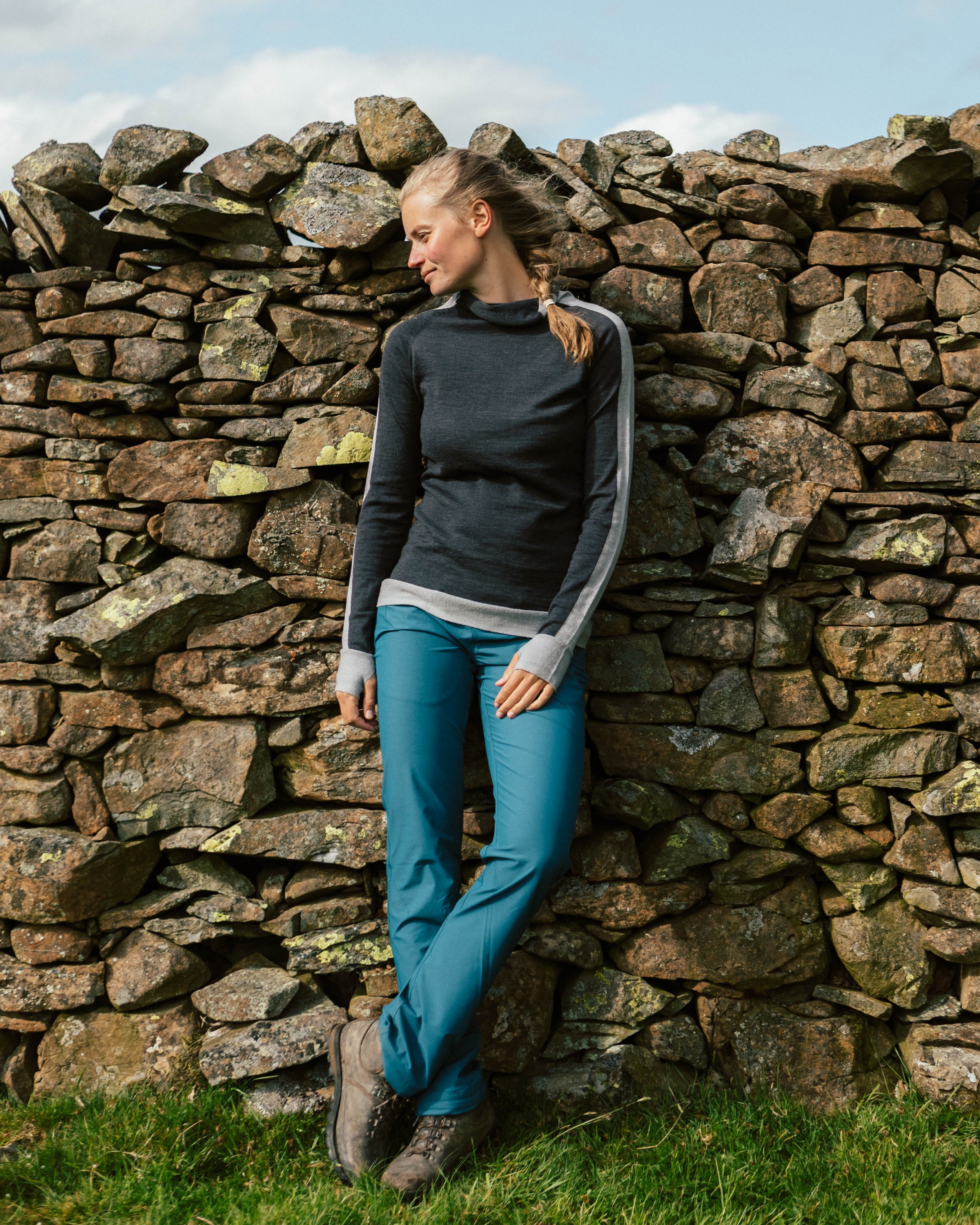What I Wear for Hillwalking — Autumn/Winter Edition
Of all the outdoor activities and adventurous pursuits I enjoy, I probably identify most as a hillwalker. The hills are simply where I feel most alive; the place I feel most at ease and most myself. For me, something I love about hillwalking is the ease of just being able to lace on a pair of boots, pack a rucksack, and go. There is less gear required than climbing, less potential for risk than other mountain sports, and no matter the weather you can still walk as long as you have the appropriate gear. That’s right, I really do believe that gear equals safety — and the more you walk, the more you’ll start investing in good quality gear that will last you years and years. I wanted to share my own personal tips on what to wear for hillwalking that I have gained over the years, to make it a little easier and safer for you to get out rambling in the hills.
Go solo or with friends; hike 2 miles, 6 miles or 20. Feel the burn in your lungs as your legs carry you up a hill, gaze in awe at the breathtaking view from a summit, and return to where you began - utterly exhausted but entirely refreshed - for a pub lunch or coffee and slice of cake.
It is worth noting that I am not a qualified Mountain Leader (though it is something I’m working towards this year), therefore this information is entirely based on personal experience, alongside some tips and tricks that I have picked up from walking with those more qualified throughout my hillwalking years. I also used to work in an outdoor store (hence why much of the gear I wear is Patagonia!), so I learned a lot about different materials and sustainability. Despite that, do always ensure you consult an expert if you have any queries. Hopefully one day I might be one!
Why is Gear Important?
Though I do consider hillwalking a beautifully simple and relatively minimal pursuit, there are still numerous things you should consider before heading out onto peaks, fells, Wainwrights or Munros:
Terrain — what kind of ground are you travelling on? Is it rocky, scrambly, grassy or muddy? Are there clearly defined footpaths? This will dictate what footwear you wear, what kind of trousers you might choose, and what navigational tools you may need.
Distance — how far is the route you have planned? In general, the longer the route, the more gear, food and water you will need to pack in order to be prepared for every eventuality. Therefore, this may change the size of your rucksack.
Weather — have you checked the weather forecast? Depending on where I’m headed, I use a mixture of good old BBC weather with MWIS thrown in for higher summits. The forecast for the day is one of the biggest indicators for what I’ll wear and what I’ll carry.
Fitness — How comfortable are you with long walks in the hills? Have you done many before, or are you just starting out? If you think you’ll be in the hills for a long time due to lack of fitness, do ensure you pack extra gear and plenty of food and water!
In a previous blogpost on Winter Mountaineering Gear, I wrote a little something about why I think having the right gear is so important. To some extent, it is sometimes possible to just lace on your boots and go, but as you feel the urge to do longer routes and harder summits, it is really important that you are prepared for what may be ahead — unpredictable weather, difficulty in navigating, technical terrain. That’s where having more technical and high-quality outdoor wear is really important. I have slowly invested over time in what I wear in the hills, and now pretty much have a couple of sets ‘hillwalking outfits’ that I know work for me. In this blogpost, I’m going to cover Autumn/Winter hillwalking which doesn’t cover baking hot, summer days nor does it cover snow — what you need for these extremities may be slightly different, but use this as a base for hillwalking gear :)
Layering
A lot of people asked me about how to layer correctly. This was also something I found hard to get right when I started out doing more hiking, but over time, as I have gotten used to my body temperatures and to the gear I own, I pretty much know what will be appropriate to wear in given weathers in the hills. Layering is really useful as it means you can regulate your temperature by taking off layers as you hike. If you get too sweaty on a hike, your core can get really cold; so being able to take some layers off for ascent and put them back on when descending is really important. In brief, at this time of year I wear the following in the hills:
Bottom Half
Walking leggings or trousers
Waterproof over-trousers (usually packed in my bag, except for on the rainy days).
Hiking socks
Hiking boots
Top Half
T-shirt/vest baselayer
Long-sleeved baselayer
Midlayer (fleece or alternative)
Insulation (choose from synthetic or down, but I prefer synthetic for the UK)
Waterproof (often packed in my bag)
Wearing Patagonia Micro Puff & Fjallraven Abisko Trekking Tights
Brands & Sustainability
Someone asked me what my go-to brands are for outdoor gear, and why I choose some over others so I thought I’d tackle that here before diving in! You’ve probably noticed I wear loads of Patagonia and that is for two reasons; one, I used to work for them and therefore got a great discount which allowed me to update all my old walking gear with what I consider to be the best in the industry! Two; Patagonia have amazing ethics on sustainability, and their gear is super high-quality with a life-time guarantee — the idea being you only need to buy one item for life, pretty great!
Other brands I like who also have good ethics are Rab, Haglofs, and FINDRA for Merino baselayers. Of course I own other items from other brands, but do tend to stick with what I know to be good quality and sustainable. Mistakes I’ve made in the past are buying cheap gear that lasts me only a short amount of time, or doesn’t quite do the job as I hoped and therefore needs replacing pretty quickly.
While I’m talking about sustainability, this is obviously something I am really passionate and the intention of this blogpost is not to encourage you to buy loads of new, expensive gear. I would, however, advise investing more in good-quality gear that serves its purpose for what you need, and that will last you a really, really long time.
I’m also a big believer in using gear for lots of purposes, so rather than having a ‘hiking jacket’ or ‘climbing trousers’, buy gear you can use for all your favourite outdoor activities. You may look at some of my gear and think it looks way too technical for a ramble in the Peak District, but that’s because I might also use it for trekking in the Himalayas or Alpine routes in Chamonix. Of course, some gear needs to be specific for the activity, but for the most-part you can mix and match all your gear for your outdoor pursuits!
If you only have a limited budget, I’d opt to buy a good pair of hiking boots and a warm yet light insulated jacket as your first and most expensive purchases — these are probably the two items I wear or carry for every hike all year round in the UK.
Wearing Rab Buff, Patagonia micro Puff & Fjallraven Abisko Trekking Tights
Short & Long-Sleeved Merino Baselayers
Wearing Icebreaker Merino Tshirt
Baselayers are super important to ensure you are both warm and dry in the hills. By dry, I don’t mean that the rain should soak right through to your baselayer, but that the baselayer should be wicking away sweat from your core. When you sweat on cold days, you can quickly become cold at your core which can be really uncomfortable and dangerous on long walks in the hills. That’s where the phrase ‘be bold, start cold’ comes from; encouraging you to set off a little but chilly knowing you’ll warm up as soon as your heart rate increases (though it’s still something I’m not very good at).
Depending on the weather, I usually wear both a Merino baselayer t-shirt and a long-sleeve over the top as my baselayers - or sometimes just one or the other. What you’re looking for with your baselayers is something that fits really well, is warm, and that wicks away sweat. When you find a good baselayer, you’ll find you can wear it for days and days in the hills without having to wash it — they are certainly a worthy investment.
Rapha Merino Tank - £50 — I also wear this for climbing indoor and outdoor, and of course it is designed for cycling!
Icebreaker Merino Cool-Lite (T-shirt) - £42 — I wore this t-shirt for 10 days in the Alps without washing, brilliant!
FINDRA Merino Long-sleeved Baselayer - £85 — warm, cosy and sustainable from a Scottish-based brand.
Berghaus Thermal Tech Tee Long Sleeved Baselayer - £50 — a good, cheaper alternative that I have found to be really good.
Mid-Layer
Wearing Patagonia Nano Air lite Hybrid Hoody & Acai Activewear Leggings
The next layer you’ll be wearing is the trusty mid-layer. This is one that you may end up hiking in as a top-layer in warmer temperatures and when ascending, or that may end up bundled under a couple more layers on cold, rainy days. For that reason, the mid-layer needs to be three things; warm, breathable, and light (by light, I mean more non-bulky so you can fit a few more layers over the top).
The fleece is the more traditional mid-layer, but nowadays many brands do fleece alternatives that are lighter and more breathable. I tend to choose a fleece if I want to feel instant warmth, or if I know the hike I’m doing is not super difficult or long, while I prefer other alternatives for longer more arduous hikes.
Patagonia Nano Air - £220 — I know this is expensive, but I honestly can’t rate the Patagonia Nano Air enough. I find the fabric so breathable, warm, light and packable. The pullover I usually wear has been discontinued, but this jacket is a similar alternative. I also wear it for climbing and Alpine. In the photo, I’m wearing a hybrid version which means the back is more stretchy and breathable, I prefer this one for Spring and Summer.
Patagonia R2 - £150 — The R2 from Patagonia is a solid, year-round fleece that will be a worthy investment. I wore this every single day when trekking the Annapurna Circuit in Nepal.
Rab Superflux Hoody - £90 — A quality fleece from Rab to see you from local peaks to mountains.
Insulation
wEARING patagonia Micro Puff
On top of your mid-layer, you’ll want a nice, warm insulated jacket. This might be your priciest purchase, but if chosen correctly you’ll find you get endless wear out of a good piece of insulation. You may have noticed that I wear the one in the photo above for basically every single walk I go on, as well as for summer Alpine climbing!
To make things simple, there are two types of insulated coat you can choose from; down or synthetic. As a general rule, down is warmer (provided it’s good quality down - 600 fill or above) but synthetic performs better when wet and is often lighter and more packable. Down performs better in cold, dry climates like the Alps, while synthetic is better in mild, damp environments like the UK.
I almost always choose a synthetic jacket in the UK as it doesn’t matter if it gets wet, whereas down will be damaged and ineffective if wet. Synthetic also usually layers better, and I love layering! Some people might not wear their insulation at all for walking, and just keep it packed in their bag for the summit or ‘just in case’, I’m a cold person and almost always hike in my coat in Autumn and Winter so choosing the right one was really important for me. Here are a few jackets I would recommend:
Patagonia Micro Puff Hoody - £250 — The coat I’m wearing in this photo is Patagonia’s Micro Puff. It is an incredibly light and warm synthetic jacket that packs small. The fabric is a little fragile, but for walking it is ideal. I love the hoody as it keeps me extra warm. Full review of this coat will be coming soon to my blog!
Patagonia Nano Puff Hoody - £195 — A slightly cheaper alternative to the Micro puff, I highly rate the Nano Puff for hillwalking. It is a little less warm and a little less light, but for the UK it is more than sufficient and saves you a few pennies.
Rab Microlight Alpine Jacket - £195 — Rab are possibly world leaders in down, and their Microlight Alpine Jacket is a great option if you’re looking for something warm and light. Just make sure you put a waterproof on to save the down in the rain!
Waterproof Coat
Wearing Haglofs L.I.M. mOUNTAIN pROOF aNORAK
I like to think my waterproof will be packed in my bag most of the time, but the truth is you might end up wearing your waterproof coat more often than not when hillwalking in the UK in Autumn and Winter — whether it’s raining or super windy, as it often is on higher peaks and fells! I have a couple of waterproofs that serve different purposes. One is a solid, Gore-Tex mountaineering coat that I choose to wear if I know the forecast has promised rain and it’s likely I’ll be wearing it all day, and the other is a lighter, packable pullover that is ideal for whipping in and out of my bag when I need it. You can, of course, get something that does both these jobs, this is just what I have opted for, for now!
Gore-Tex is a good benchmark for waterproofing, however some brands also have their own waterproofing standard, such as Patagonia’s H2No. For hillwalking in Autumn and Winter, you want a waterproof that will keep you fully protected against the elements whilst also being breathable. It’s also now possible to get recycled Gore-Tex, and waterproofing standards in the UK have changed so the top layer of DWR (Durable Water Repellency) is now a little kinder to the planet.
Haglofs L.I.M. Mountain Proof Anorak - £168 — I originally got this jacket when heading to the Alps, because it would pack down small into my bag and the pullover style works well with a harness. I now also use it for many hillwalks in the UK and find it to be a comfortable, solid, breathable waterproof.
Patagonia Triolet Jacket - £325 — Patagonia’s Triolet is probably the best option as an all-year round hillwalking coat that you could also use for mountaineering.
Montane Pac Plus Jacket - £180 — A solid option for hillwalking and long-distance trekking that is light, breathable and packable.
Walking Trousers
wearing Patagonia RPS Pants, Patagonia Micro Puff Jacket & Lowe Alpine Manaslu 55:65 HIKING PACK
A good pair of walking trousers are hard to come by, but when you find a good one, you’ll never let them go! That’s what it’s been like for me anyway. I think it’s especially hard for women to find good outdoor trousers due to us all having curves in different places. I have a small waist but larger thighs, which means trousers often cling to my legs but don’t fit at the waist.
For me, a good outdoor trouser should be tough, have pockets (I love thigh pockets), water resistant and you should feel good and comfortable wearing them. I really like hiking in leggings, but sometimes they fall down at the crotch or are too long or short at the leg. Luckily, I’ve found three pairs of ideal hiking trousers that I adore!
Fjallraven Abisko Trekking Tights - £155 — These leggings may be pricey but I can’t rate them highly enough! They fit so well, are super comfy and have reinforced sections on the bum and knee that make them ideal for scrambling and hiking. I reviewed them here.
Patagonia RPS Pants - £95 — Designed for climbing, but these are my go-to walking trousers. They are breathable, have loads of movability and also keep you really nice and warm in winter. I’d recommend trying them on as Patagonia tend to have a long-length and don’t fit as well on shorter people (I’m 5’7”).
ACAI Activewear Skinny Outdoor Trousers - £72 — I’m a fan of these in the Autumn especially as they are comfortable, flattering and practical. They have a great water-resistant finish and stretch. I reviewed them here.
Wearing Patagonia Nan Puff and Fjallraven Abisko Trekking Tights
Hiking Boots
Probably the most important thing you’ll head to the hills with is a good pair of hiking boots! I could write a whole blogpost on how to choose a boot, but for now I’ll tell you a bit about my experiences. In the last 6-ish years of walking I’ve only had two pairs of hiking boots. The first was a pair of Berghaus boots that I believe are now discontinued (a similar version is here). They were a suede fabric and fit perfectly straight away. I never had blisters, they provided instant comfort and saw me through years of travels and hillwalks.
In the last couple of years, I’ve been doing longer hikes with more weight and on tougher terrain, so when my Berghaus boots eventually came to an end, I knew I wanted a solid, leather boot and Altberg seemed ideal, fit well and were hand-made in Yorkshire, my home. I will be doing a full review of the boots once they’ve had a bit more wear.
In terms of what boots you should go for, I’d highly recommend a boot that is waterproof and that goes over your ankle. A 3-season boot is ideal for UK hillwalking, without being too heavy or bulky. If it’s your first pair, suede boots are really comfy, while leather boots take a bit more breaking in. Make sure you try them on with a pair of hiking socks, and ask for advice from the sales associate as they usually have lots to give!
Altberg Malham Hiking Boot - £195 — My new walking boots that are leather, waterproof and durable.
Berghaus Hillwalker Trek Goretex Boots - £120 — Similar to my first pair of hiking boots, these broke in straight away and lasted me 5 years of walking.
Scarpa Mistral GTX - £150 — Ideal for UK hillwalking, I really rate Scarpa as a shoe brand and they will also resole your boots when they wear down!
Accessories
It’s super important to keep your extremities nice and warm, so for Autumn and Winter hillwalking I always wear a headband or woolly hat, some really good walking socks, gloves, and a buff if it’s really cold. Here are a few I’d recommend:
Gloves
Rab Baltoro Glove - £60 (a thicker glove more for really rainy or cold days)
Heatholders Thermal Goves - £14.99 (a less technical but super warm glove, a real game-changer)
Rab Phantom Grip Glove - £32
Hat
RMBLR Shining Circular - £19.99
Patagonia Brodeo Beanie - £30
Pachamama Heaband - £11.95 (not the exact headband I have as I got mine in Nepal, but one very similar!)
Thank you so much for reading this blogpost! I feel there is a lot to cover on this topic, so if you have any other questions please ask down below. Next week I’ll be putting together a blogpost on what I pack in my rucksack, so do look out for that!
Happy hillwalking!
Athena x




